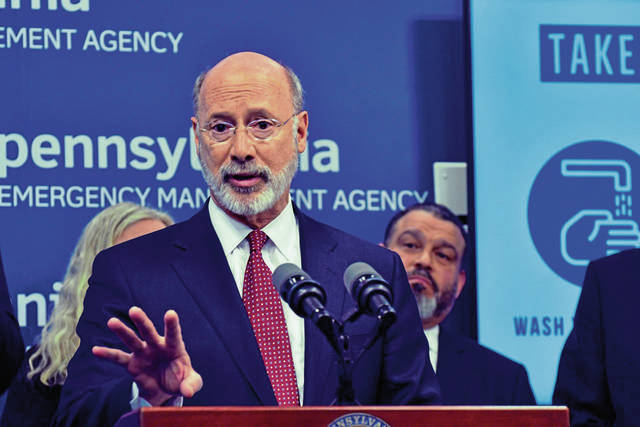Pennsylvania receives $523.8M to support schools during pandemic
Pennsylvania will receive $523.8 million in federal funding to help schools respond to the coronavirus pandemic, Gov. Tom Wolf announced Wednesday.
The money from the U.S. Department of Education is available through the Elementary and Secondary School Emergency Relief Fund. The Pennsylvania Department of Education applied for a grant last week.
“Our schools and educators have been working tirelessly to help students and their families during this crisis,” Wolf said in a statement. “These efforts must be paired with investments that reflect the unprecedented scale of this challenge.”
School districts and charter and cyber schools can begin applying to the state Department of Education for funding. Schools and districts can expect to start receiving money within the next several weeks, according to a news release.
Each entity will receive an amount proportional to federal Title I-A funds received in 2019 under the Every Student Succeeds Act.
Under the Coronavirus Aid, Relief and Economic Security (CARES) Act, at least 90% of the money will go to traditional public schools and charter schools, equaling about $471 million. The remaining money will be used for state-level activities and initiatives that support the state’s 500 school districts.
Schools can use the funding to address needs that have arisen because of the coronavirus pandemic, including food service, professional training, technology, sanitation, summer and after-school programs and mental health services.
Several school districts expressed uncertainty about how they can use their share of the money.
Discussions at the state level for a potential property tax freeze and possible cuts to subsidies for special education, transportation and other needs could put a strain on budgets, district leaders say. The Pennsylvania Association of School Business Officials released a report recently that predicted more than $1 billion total loss in local revenues across the state’s districts.
The federal funding does not appear to be intended for such expenses.
“There’s a little bit of a catch to it,” said McKeesport Area School District Superintendent Mark Holtzman.
Holtzman said the money comes with additional “nuances” because it is based on Title I-A funding, which districts must normally share with nonpublic schools. It’s not clear yet to district leaders whether the CARES Act funds will be shared in the same way, he said.
Still, Holtzman said McKeesport Area is poised to take a “leap of faith” and plans to spend at least part of its $1.8 million allocation on technology needs. The district has to get the order in sooner rather than later, he said, in order to prepare for the fall.
“We’re excited about it,” he said. “We hope that it is truly extra money to kind of stimulate our district and give us an opportunity to provide one-to-one devices to some degree to our students and kind of be competitive with other school districts. This is really what we anticipate being able to use that money for.”
At Kiski Area School District, Superintendent Tim Scott also said the district is waiting for more specific guidance on how the grant funds will affect subsidies and other budgetary concerns before deciding how it will use its money. However, he said, it’s likely the funding will be needed to supplement the district’s supply of laptops. Kiski Area is slated to receive $607,894.
“Even when we were 100% brick and mortar, we still had a cycle of technology needing replenished,” Scott said.
Plans for technology purchases were a trend across districts. While the extent to which the federal funding will offset reductions in state funding remains unclear, Ryan Kirsch, business affairs director for Norwin School District, said the money will address immediate instructional technology needs. Norwin is to receive $336,698.
“We are anticipating a push for more online options as schools reopen in the fall,” Kirsch said.
Yough Superintendent Janet Sardon said her district intends to use its $314,639 allocation to purchase more Chromebooks and maybe some iPads “to make it more equitable for the students.” The funds also will be used to sanitize school buildings and to provide tutoring in summer learning programs.
Penn-Trafford also will use the $258,579 the district will receive for to buy additional computers in the first and second grades so it will have the electronics for all studeents district-wide, said Matt Harris, Penn-Trafford superintendent.
At Greensburg Salem, the district will use some of the the money to enhance its online learning by purchaseing laptops and tablets, as well as improving the technology infrastructure, said Superintendent Gary Peiffer.
“We’re mapping it out,” Peiffer said.
Money also will be spent on personal protective equipment, sanitizing the buildings and adding Plexiglass barriers were needed.
The district has to make sure the schools are safe for students and staff when they return in the fall, Peiffer said.
Funds must be used by September 2022, and schools are encouraged to prioritize investments for vulnerable students and families. Many educators say covid-19 and the exodus to distance learning has highlighted inequities among school districts and communities.
Students with disabilities, English learners and students living in poverty are among those most at risk for dramatic learning loss during school closures.
Remove the ads from your TribLIVE reading experience but still support the journalists who create the content with TribLIVE Ad-Free.

